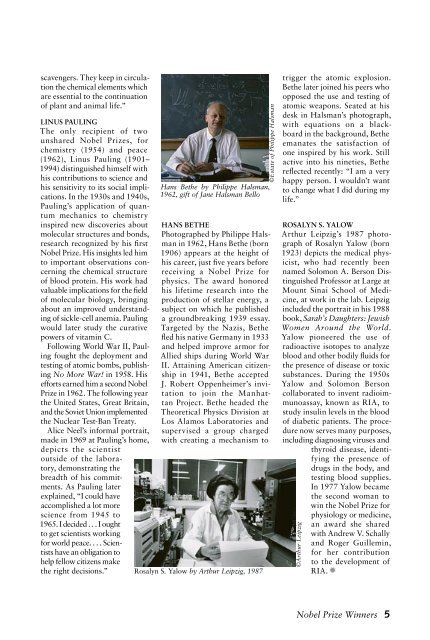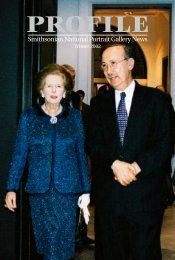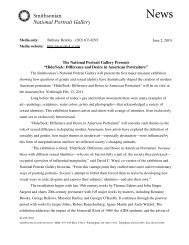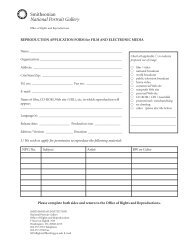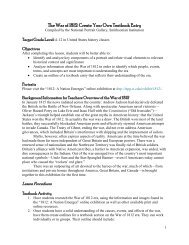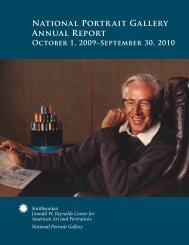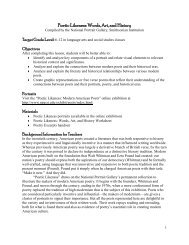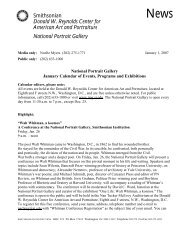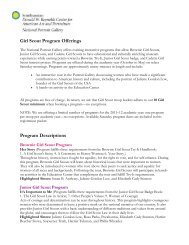Cambridge, Mass.: Da Capo Press, 2003 - National Portrait Gallery ...
Cambridge, Mass.: Da Capo Press, 2003 - National Portrait Gallery ...
Cambridge, Mass.: Da Capo Press, 2003 - National Portrait Gallery ...
You also want an ePaper? Increase the reach of your titles
YUMPU automatically turns print PDFs into web optimized ePapers that Google loves.
scavengers. They keep in circulation<br />
the chemical elements which<br />
are essential to the continuation<br />
of plant and animal life.”<br />
LINUS PAULING<br />
The only recipient of two<br />
unshared Nobel Prizes, for<br />
chemistry (1954) and peace<br />
(1962), Linus Pauling (1901–<br />
1994) distinguished himself with<br />
his contributions to science and<br />
his sensitivity to its social implications.<br />
In the 1930s and 1940s,<br />
Pauling’s application of quantum<br />
mechanics to chemistry<br />
inspired new discoveries about<br />
molecular structures and bonds,<br />
research recognized by his first<br />
Nobel Prize. His insights led him<br />
to important observations concerning<br />
the chemical structure<br />
of blood protein. His work had<br />
valuable implications for the field<br />
of molecular biology, bringing<br />
about an improved understanding<br />
of sickle-cell anemia. Pauling<br />
would later study the curative<br />
powers of vitamin C.<br />
Following World War II, Pauling<br />
fought the deployment and<br />
testing of atomic bombs, publishing<br />
No More War! in 1958. His<br />
efforts earned him a second Nobel<br />
Prize in 1962. The following year<br />
the United States, Great Britain,<br />
and the Soviet Union implemented<br />
the Nuclear Test-Ban Treaty.<br />
Alice Neel’s informal portrait,<br />
made in 1969 at Pauling’s home,<br />
depicts the scientist<br />
outside of the laboratory,<br />
demonstrating the<br />
breadth of his commitments.<br />
As Pauling later<br />
explained, “I could have<br />
accomplished a lot more<br />
science from 1945 to<br />
1965. I decided . . . I ought<br />
to get scientists working<br />
for world peace. . . . Scientists<br />
have an obligation to<br />
help fellow citizens make<br />
the right decisions.”<br />
Hans Bethe by Philippe Halsman,<br />
1962, gift of Jane Halsman Bello<br />
HANS BETHE<br />
Photographed by Philippe Halsman<br />
in 1962, Hans Bethe (born<br />
1906) appears at the height of<br />
his career, just five years before<br />
receiving a Nobel Prize for<br />
physics. The award honored<br />
his lifetime research into the<br />
production of stellar energy, a<br />
subject on which he published<br />
a groundbreaking 1939 essay.<br />
Targeted by the Nazis, Bethe<br />
fled his native Germany in 1933<br />
and helped improve armor for<br />
Allied ships during World War<br />
II. Attaining American citizenship<br />
in 1941, Bethe accepted<br />
J. Robert Oppenheimer’s invitation<br />
to join the Manhattan<br />
Project. Bethe headed the<br />
Theoretical Physics Division at<br />
Los Alamos Laboratories and<br />
supervised a group charged<br />
with creating a mechanism to<br />
Rosalyn S. Yalow by Arthur Leipzig, 1987<br />
©Estate of Philippe Halsman<br />
trigger the atomic explosion.<br />
Bethe later joined his peers who<br />
opposed the use and testing of<br />
atomic weapons. Seated at his<br />
desk in Halsman’s photograph,<br />
with equations on a blackboard<br />
in the background, Bethe<br />
emanates the satisfaction of<br />
one inspired by his work. Still<br />
active into his nineties, Bethe<br />
reflected recently: “I am a very<br />
happy person. I wouldn’t want<br />
to change what I did during my<br />
life.”<br />
ROSALYN S. YALOW<br />
Arthur Leipzig’s 1987 photograph<br />
of Rosalyn Yalow (born<br />
1923) depicts the medical physicist,<br />
who had recently been<br />
named Solomon A. Berson Distinguished<br />
Professor at Large at<br />
Mount Sinai School of Medicine,<br />
at work in the lab. Leipzig<br />
included the portrait in his 1988<br />
book, Sarah’s <strong>Da</strong>ughters: Jewish<br />
Women Around the World.<br />
Yalow pioneered the use of<br />
radioactive isotopes to analyze<br />
blood and other bodily fluids for<br />
the presence of disease or toxic<br />
substances. During the 1950s<br />
Yalow and Solomon Berson<br />
collaborated to invent radioimmunoassay,<br />
known as RIA, to<br />
study insulin levels in the blood<br />
of diabetic patients. The procedure<br />
now serves many purposes,<br />
including diagnosing viruses and<br />
thyroid disease, identifying<br />
the presence of<br />
drugs in the body, and<br />
testing blood supplies.<br />
In 1977 Yalow became<br />
the second woman to<br />
win the Nobel Prize for<br />
physiology or medicine,<br />
an award she shared<br />
with Andrew V. Schally<br />
and Roger Guillemin,<br />
for her contribution<br />
to the development of<br />
RIA.<br />
©Arthur Leipzig<br />
Nobel Prize Winners<br />
5


